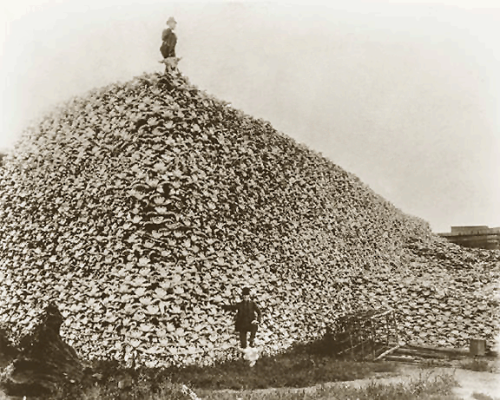 gkojax:
gkojax:yuiseki:
tomisima:
via blog.geisai.net
 akubizone:
akubizone:mirc:
Bison Skulls, ca. Mid-1870s ****:THE SLAUGHTER OF THE BISON The extermination of the bison was inevitable. The plains and prairies that supported those roaming herds of huge beasts are now dotted with cities and towns, crossed by a network of railroads and highways, plowed to produce vast acreages of wheat, corn, cotton and other crops, or fenced and grazed by millions of cattle and sheep. We should be ashamed of the cruel senseless waste when they were slaughtered and left to rot but the cold fact is that the buffalo were doomed by civilization. Until we came, the Indian was still living in the Stone Age. His weapons were primitive, his needs were simple, and until horses appeared — wild descendants of those left behind by the early Spanish explorers — his only domestic animal and beast of burden was the dog. At least nine tribes of Plains Indians, such as the Sioux-and Comanche, were nomads who depended almost entirely upon the buffalo, but they killed no more than what they could use — usually less. To several other tribes, like the Pawnee and Kansas, who lived in villages and grew corn, tobacco and other crops, the buffalo was less essential. That was even more true of the eastern “woodland” Indians. The typical Plains tribes attempted no agriculture and made no pottery. There culture, including their religion and mythology, was based wholly upon the bison which furnished them with food, clothing, weapons, tools, utensils and shelter. Their teepee was a conical framework of long slender poles covered with dressed buffalo hides. They used every part of the animal. Its flesh was their chief food, supplemented by berries, edible roots, and by corn obtained from other tribes. The tongue was a delicacy and the liver was eaten raw. The surplus meat was dried into “jerky” to be eaten in emergencies or pulverized and mixed with tallow, marrow and berries to make pemmican. The brains were used in preparing skins for robes, moccasins, leggings, shirts, parfleches and bags. Buffalo hides were stretched over the frames of saddles, shields, and the tub-like “bullboats” for crossing rivers. Spoons and other articles were made from the horns which, with the hoofs, also furnished glue. Small bones were used for needles and awls; larger ones for weapons; shoulder blades for hoes. Buffalo droppings or “chips ” were the principal fuel on those treeless plains. The wholesale slaughter of the bison began after the Civil War, at first for their meat — of which only the tongue, hump and hindquarters were used. During the 70’s and early 80’s, millions were killed for their hides alone, and the carcasses left to rot. As the railroads penetrated the West, they advertised cheap excursions for “sportsmen” who liked to see how many buffalo they could kill in one day. Eventually the bones, which in many areas covered the plains as far as one could see, were gathered by nesters (homesteaders), and a strange wild breed of men called “bonepickers”, shipped East, and used for fertilizer or to make charcoal for refining sugar. Then there was nothing left of the buffalo But a memory. In l900 there were only about 800 left alive.
good little pussy...









5 comments:
,,,Hi Akubi,,,
{{{Sadmursts}}}
Hi Kitty!
Agreed - but I really liked your commentary.
I dislike the commentary of my insane upstairs neighbors, though so I'll sign off and take a shower.
TGIFF Akubi!
I couldn't stand it. Edgar online baybee, not looking as good as the woman on the high-line, butt whatever. Badda boomp!
Hi Edgar.... let's see... what day is it?....?....?
Post a Comment